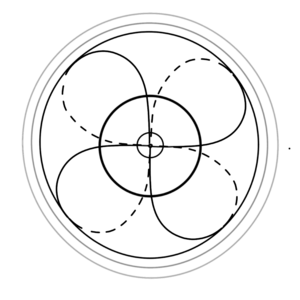ReturnBeat
return beat
The return beat is transmitted through a praxis I refer to as the Golden Triangle, which uses rhythm as a vehicle that integrates song or spoken word with movement or dance and with percussion or drumming. This integrated triple praxis is then used as a starting point to experience individual and cultural modes of being, becoming, and performance as part of a perception of a plethora of living forces of planet Earth.
Principally, the return beat is a rhythmic paradigm that underpins the embodied knowledge of both Pan African people, in other words people who live on the African continent and people of the Pan African cultural diaspora, who are people of African descent living outside the continent. This embodied knowledge applies a traditional fractal aesthetic in the creation and production of temporal space. This traditional African aesthetic is binary in nature and manifests as endless bifurcations of single pathways. It can be identified in weaving patterns, traditional ornamentation of buildings and utensils, but also in certain images that the mathematician Mandelbrot created to visualize so-called fractals. It observes as well as expresses the continuous twinning process that is required for living bodies to propagate in the world. This aesthetics not only depicts patterns, it also includes the agency of a living body to navigate them, to choose a single pathway in those bifurcating spaces.
return beat and physical journal
Physical journal is a way to conceptualize living bodies from the perspective of a practitioner’s lived experience. The physical journal is formed by both genetically and culturally embodied memories that neurologically construct a kind of virtual body, which is holographically projected as our experience of being a lived body. The physical journal is an intertwined set of embodied spatial memories that act as reference frame for living bodies to write and rewrite themselves through experience. It is the spatialized memory of the body itself that acts both as counterpoint for new experiences and as the spatial fabric where these experiences are being inscribed.
The return beat draws attention to the temporal location of the beats as well as the spaces between the beats, as experienced in relation to the physical journal’s encounter with the rhythmic flow, The phenomenon of return beat is a specific cultural experience of tempo and its flow within any given rhythm, which is the nature of the beat itself. The resonant embodied understanding of the return beat is experienced as a curve leading back to the individual’s sense of self, being, and awareness. By echoing the metabolic circular rhythm of our heartbeat, we create an outgoing (centrifugal) and a returning (centripetal) experience pertaining to the duration between repetitive beats. These beats are perceived to emerge from visceral pathways in our embodied experience.
away from static temporal space
Western temporal-spatial understanding describes repetition as static patterns in duration. This understanding, which neglects the experiencing-performing body and limits itself to repetitive phenomena in a fixed and passive temporal arena, subjugated the Yoruba perspective. It ridiculed the transformative potential of repetition, constraining the understanding of what is rhythmically repetitious and discarding it as unevolved and predictable.
Through this Westerns lens, the concept of a return beat that mobilizes notions of returning to the same experience in distributed regions of time-space, may produce an embodied fear of stagnation. However, if we move away from the disembodied, static perceptions of temporal space—a perceptual hangover from dualism in the Enlightenment—to a more dynamic quantum perception that includes the living body, then repetition does not unfold in stasis but in pulses and waves. Temporal space is then not an empty arena for events to unfold but a substance that contains and yields energy.
